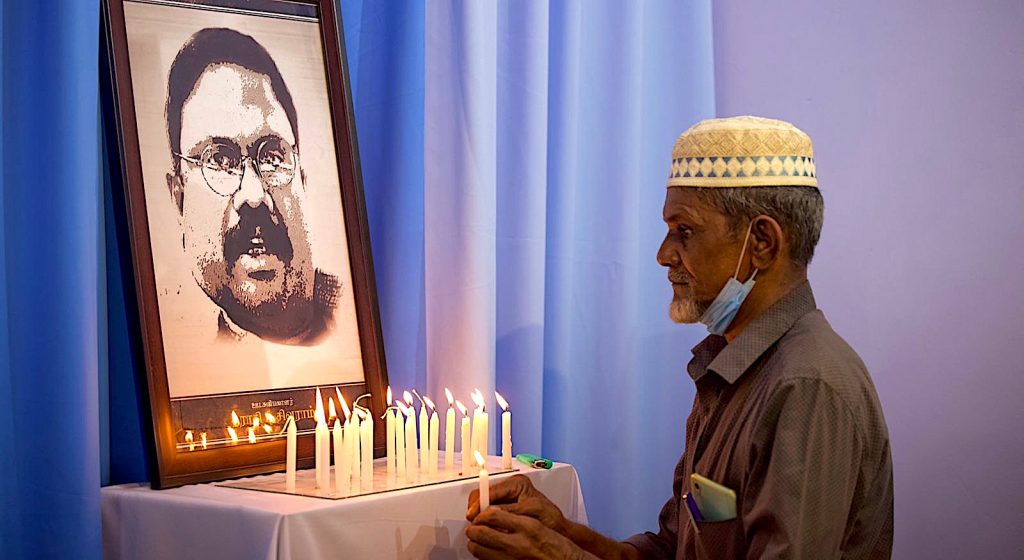Photo courtesy of srilankatwo
Among the many human rights violations that have occurred in the country in recent decades, the abduction and killing of Dharmaratnam Sivaram, also known as Taraki, stands out. Investigating this case and bringing the perpetrators to justice was an election promise of the NPP government. President Anura Kumara Dissanayake said that Sivaram’s case was among a select number of human rights violations currently under investigation. April 28 marked 20 years since Sivaram was killed.
Born on August 11, 1959 into an upper middle class family in Batticaloa, Sivaram received his primary education at St. Michael’s College in Batticaloa and later attended Aquinas College in Colombo. He entered the University of Peradeniya in 1982 to pursue a Bachelor of Arts degree in English Literature.
However, amid rising Tamil public opposition both inside and outside the university, Sivaram abandoned his degree and turned to politics. He joined the Gandhian movement, which aimed to protect and uplift the oppressed Tamil community.
By 1983 the UNP government had begun cracking down on the Gandhian movement. Several prominent Gandhian leaders were arrested and imprisoned. During the Welikada Prison massacre, many of them were killed.
Deeply shaken by the massacre and the loss of his comrades, Sivaram chose to take up arms and joined the People’s Liberation Organisation of Tamil Eelam (PLOTE). He soon distinguished himself through strong leadership both in the political and military wings of the group.
Following the Indo-Lanka Accord of 1987, Sivaram became the general secretary of the Democratic People’s Liberation Front (DPLF), the political front affiliated with PLOTE. However, he left the organisation shortly afterwards due to ideological differences with its leader, Uma Maheswaran.
Sivaram then found his path into journalism through his friendship with journalist Richard de Zoysa. Their connection, formed during Sivaram’s time as the DPLF Secretary, opened the door for him to join The Island newspaper as a freelance journalist.
Recognised as a sharp war and political analyst, Sivaram contributed insightful articles to The Island, Sunday Times, Midweek Mirror, Daily Mirror, Veerakesari and Tamil Times. In 1997, he became the editor of the TamilNet website. Under his leadership, the site quickly gained international recognition as a key source of news for the Tamil community during the civil conflict.
In 2001, he co-founded the North Eastern Herald Journal with journalist J. Tissanayagam. A few years later, they published the North Eastern Monthly magazine.
On April 28, 2005 Sivaram met journalist Kusal Perera, trade unionist Ravi Kumudesh and social activist Prasantha Ratnayake at the Bambalapitiya Bar, where they stayed until almost midnight. Kumudesh and Prasantha were the first to say goodbye and head home.
While Sivaram was with Kusal on the street, a group of men jumped out of a vehicle that had stopped in front of them, forcibly dragged Sivaram into it and sped away. The abduction took place in front of the Bambalapitiya Police Station. Kusal went home and later stated that his mobile phone had been disconnected.
Everyone who heard about Sivaram’s abduction made great efforts to save his life. However, the efforts were in vain; Sivaram had been shot dead and his body was discovered the next morning, April 29, near the parliament complex. An unknown organization called the Theraputtabhaya Balakaya claimed responsibility for his murder.
Due to domestic and international pressure, the government of President Chandrika Bandaranaike initiated an investigation into Sivaram’s murder.
Arumugam Skandaraja, alias Peter, a member of the PLOTE, was arrested on suspicion of the murder. Peter, who was arrested by the CID in Wellawatte, is the driver of the current PLOTE leader, Dharmalingam Sidharthan.
Peter, born in Trincomalee, joined PLOTE in 1984, initially working in the communications unit. He received weapons training under Uma Maheswaran in India and was reassigned to the communications unit. When the Indian Peace Keeping Force arrived in Sri Lanka, Peter joined PLOTE camps in the Vanni and Mannar. He was sentenced to prison for participating in the failed coup in the Maldives. After his release Peter became Sidharthan’s driver.
The SIM card belonging to Sivaram’s mobile phone number was found in the possession of Peter, who was arrested. The SIM card was in Sidharthan’s car. Peter told the CID that it was given to him by a man named Raju. The car was seized by the police on suspicion of being used in the kidnapping and its registration number led to the address of the Ministry of Parliamentary Affairs. However, witnesses said that the vehicle Sivaram was abducted in was a different one. The suspects who were arrested have been released and the investigation has remained dormant for several years.
The open letter to Karuna written by Sivaram after the Karuna faction split from the LTTE is considered one of the most significant pieces written in the history of the Tamil Eelam struggle. Nilanthan, a political analyst for the Eelam newspaper, speculated that Sivaram may have been a target of Karuna.
Fifteen years after the killing Vaishnavi, Vaitaki and Andrew – Sivaram’s three children – wrote an article calling for justice not only for their father but for all Tamils affected by the war.
“That is why we feel it is essential to remember all those who died during the war, especially the thousands of Tamils massacred in the Mullivaikkal war. Holding the Sri Lankan government accountable for the war crimes committed in the Mullivaikkal massacre is justice for our father in this era. Justice and accountability are needed for the Tamil families who lost loved ones who are still missing after surrendering to the forces in the final stages of the armed conflict. Justice is needed for the families who continue to live in displacement, and for all those who live under state oppression in the North and East,” they said.
